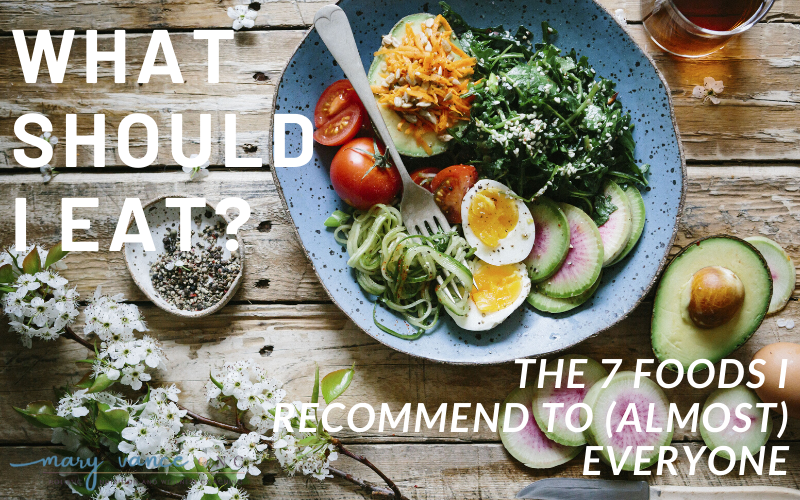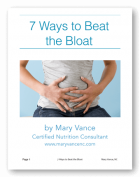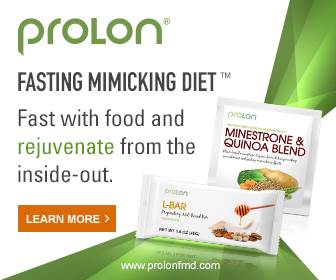Figuring out what to eat these days is downright confusing. (that’s a main reason why I have a job). Paleo, keto, gluten free, carnivore, vegan, vegetarian, how on earth do we figure out what’s best with all the conflicting information out there?
Let me make it easy for you: There is no one diet that works for everyone. We all have unique nutritional needs based on our genetics, gender, stress level, activity level, age, and current health status. Accounting for all these variables, there are still a number of foods with high nutritional value that I find myself recommending to nearly everyone. So when asking yourself, what should I eat, here are the TK foods I recommend for (almost) everyone.
What Should I Eat?
The million dollar question is, what is the best diet for human health? We’ve done some observational studies–observational meaning you can’t lock humans up in a lab to do controlled studies, so we observe over long periods of time what seems to work best–and the conclusion is the Blue Zone diet seems to be the best diet for longevity and overall health. Keep in mind that eating for health doesn’t just mean absence of disease, but also feeling your best and thriving.
The Blue Zones are five regions in Europe, Latin America, Asia and the U.S. that have the highest concentrations of centenarians (people who live to be 100 or over) in the world. These are regions where people have a 3 times better chance of reaching 100 than Americans do. To qualify as a Blue Zone, these communities also have to be largely free of afflictions like heart disease, obesity, cancer and diabetes.
The Blue Zone diet is plant-based, meaning plenty of fruits, vegetables, legumes, with minimal animal protein, often seafood, and healthy fats like nuts and olive oil. This diet also includes particular superfoods specific to the region; for example, in Okinawa they consume a lot of sea vegetables and fish. In Greece they consume a lot of olive oil.
Of course the caveats I discussed above (genetics, gender, etc) factor in to whatever diet is ideal for you, but we do know an anti-inflammatory diet is the most important diet to prevent disease, and the Blue Zone diets are largely anti-inflammatory. Inflammation is a main cause of disease. (source)
The Seven Foods I Recommend for Everyone
When I design meal plans for my clients, I explain to them that their immediate diet may not be their long term diet. That is to say that if they are working to heal a specific condition, they will need a therapeutic diet specifically designed to promote healing. Hormone balancing diets require healthy fats, for example, while gut healing diets may require you to adjust the amount and types of carbs you eat. Often these diets restrict certain foods or food groups that may be irritants: lectins or FODMAPs, for example.
But as time goes on, one can and should diversify. And the body’s needs change throughout one’s life, so one’s diet should be adjusted to support that. During times of stress, for example, you need additional protein and immune boosting nutrients like zinc and vitamin C. If you’re training for something like a marathon or planning a pregnancy, you’ll also need additional nutrients.
That aside, here are the foods I recommend for (almost) everyone.
A couple things to keep in mind here:
- These are very general recommendations for the average person who is not working to heal any specific health issues. If you have a condition or illness such as IBS, IBD, or autoimmune disease, for example, certain foods here may not work for you. There are specific very diets I recommend for people with certain digestive issues, for example.
- These foods are anti-inflammatory, support healthy weight, and are great for gut health. And really, that’s what we’re all going for.
Probiotic & Prebiotic foods: probiotic bacteria make up the majority of your microbiome and digest your food for you. They also make certain vitamins, make up the bulk of your immune system, and help regulate your weight. Prebiotic foods are specific fibrous foods that feed your probiotic bacteria so they can properly set up colonies to call home in your gut. So it’s important to get a mix of both. Probiotic foods are fermented, and the fermentation process produces bacteria and enzymes. Find these in raw kraut, water kefir (I like and drink this one), yogurt, or check out my fermented watermelon rind recipe! Prebiotic foods include alliums, banana, artichoke, asparagus. Read more about how to feed the ecosystem in your gut here.
Omega 3-rich foods: these are your anti-inflammatory superstars necessary for brain, skin, hormonal, and joint health. Omega 3s are essential, meaning your body cannot produce these fatty acids so you must get them from diet. The best food sources of omega 3s are wild salmon, sardines, sablefish (black cod), walnuts, chia, hempseeds, and flaxseeds. Also great for gut health.
Fats: the right fats in your diet are crucial for so many different aspects of your health. Fats keep your cell membranes permeable so nutrients can get in there and nourish your cells. Fats are essential for brain health (cognition), energy, joint health, skin, hair, and are the building blocks of your hormones. Many people are deficient in the right types of fats because they’re avoiding fat altogether or consuming primarily inflammatory vegetable oils like corn, soy, or trans fats. You need a mix of saturated, mono-, and polyunsaturated. Get your good fats from primarily from fish, nuts, seeds, avocado, olive oil, and coconut oil. These fats nourish your body and fight inflammation. How much fat you need depends on you! (your genetics, lifestyle, etc). Read my guide to fats here.
Cruciferous: these guys contain the sulfurous compound sulforaphane that is necessary for detox. The crucifers include broccoli, cauliflower, Brussels sprouts, kale, collards, etc. They support healthy liver function and detox, support estrogen detox, and are also anti-inflammatory. I love these roasted. Try roasted cauliflower or roasted broccoli to get more of these guys.
Berries, pomegranate: as far as fruits go, these are the superstars. Berries are super anti-inflammatory (notice a theme here with anti-inflammatory everything?) and offer protection from oxidative stress, cardiovascular disease, and metabolic syndrome. Wild blueberries in particular are great for brain health. Raspberries are very high in fiber. I use berries in my morning smoothies. Pomegranates are super anti-inflammatory and protect against heart disease. Read all about their benefits and how to eat them here. They’re one of my favorites.
Wild seafood: as far as proteins go, it’s hard to beat the anti-inflammatory benefits of seafood. You know that wild, fatty fish and sardines are high in anti-inflammatory omega 3s, and shellfish like shrimp and scallops are high in iodine, a mineral crucial for thyroid and metabolic function.
Dark leafy greens: kale, spinach, chard, collards pack a deep phytonutrient punch. These leafys are cancer fighters and a great source of vitamin K that is necessary for cardio protection and to absorb vitamin D. These guys are also anti-inflammatory and rich in nutrients and fiber. I like mine sautéd with garlic, a sulfur herb that is also great for immune and gut health.
Bonus: tea! Tea is one of the healthiest bevs you can drink. Tea also contains polyphenols that feed your gut bugs to keep you healthy. And green tea in particular is– you guessed it– anti-inflammatory. I LOVE these teas and spend way too much money on them LOL. Read my guide to drinking tea here.
Pin it!

Mary Vance is a Certified Nutrition Consultant and author specializing in digestive health. She combines a science-based approach with natural therapies to rebalance the body. In addition to her 1:1 coaching, she offers courses to help you heal your gut and improve your health. Mary lives in San Francisco and Lake Tahoe in Northern California. Read more about her coaching practice here and her background here.








Great tips. I started eating healthy when I had issues with digestion. That’s why I started eating foods that are good for your gut. Thank you for sharing this post. 🙂